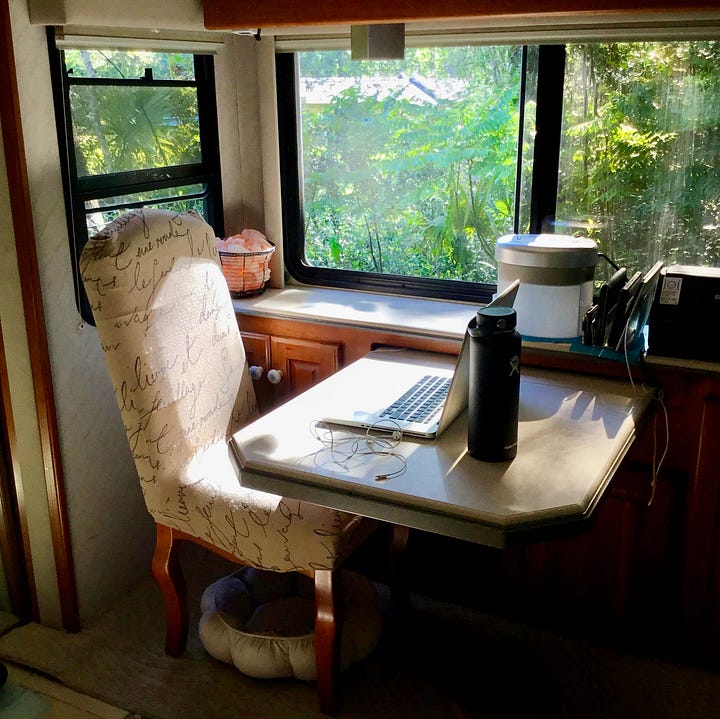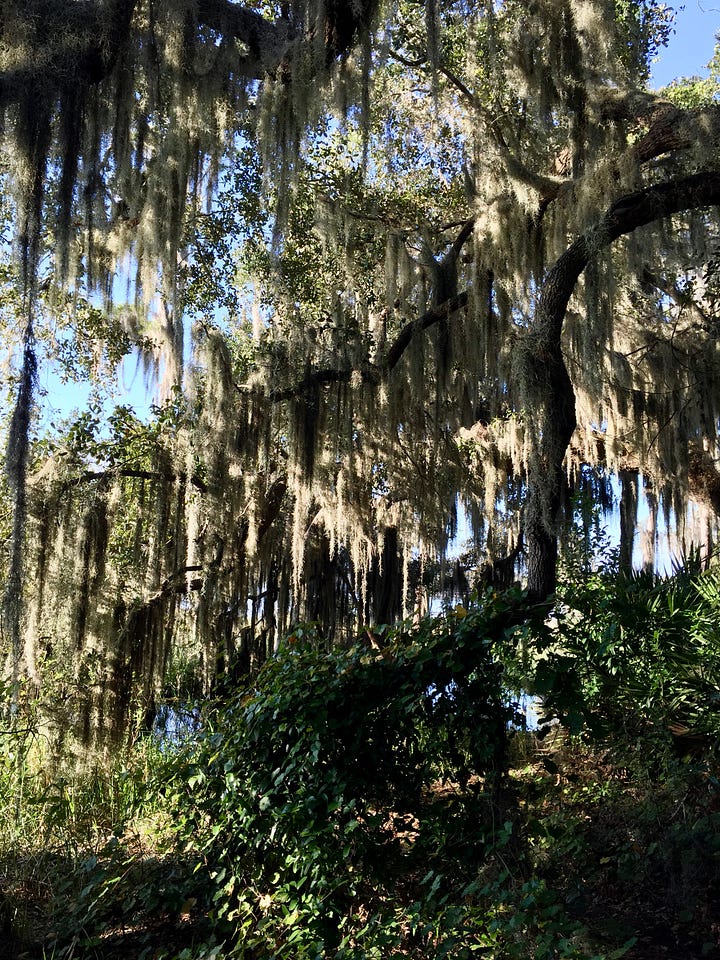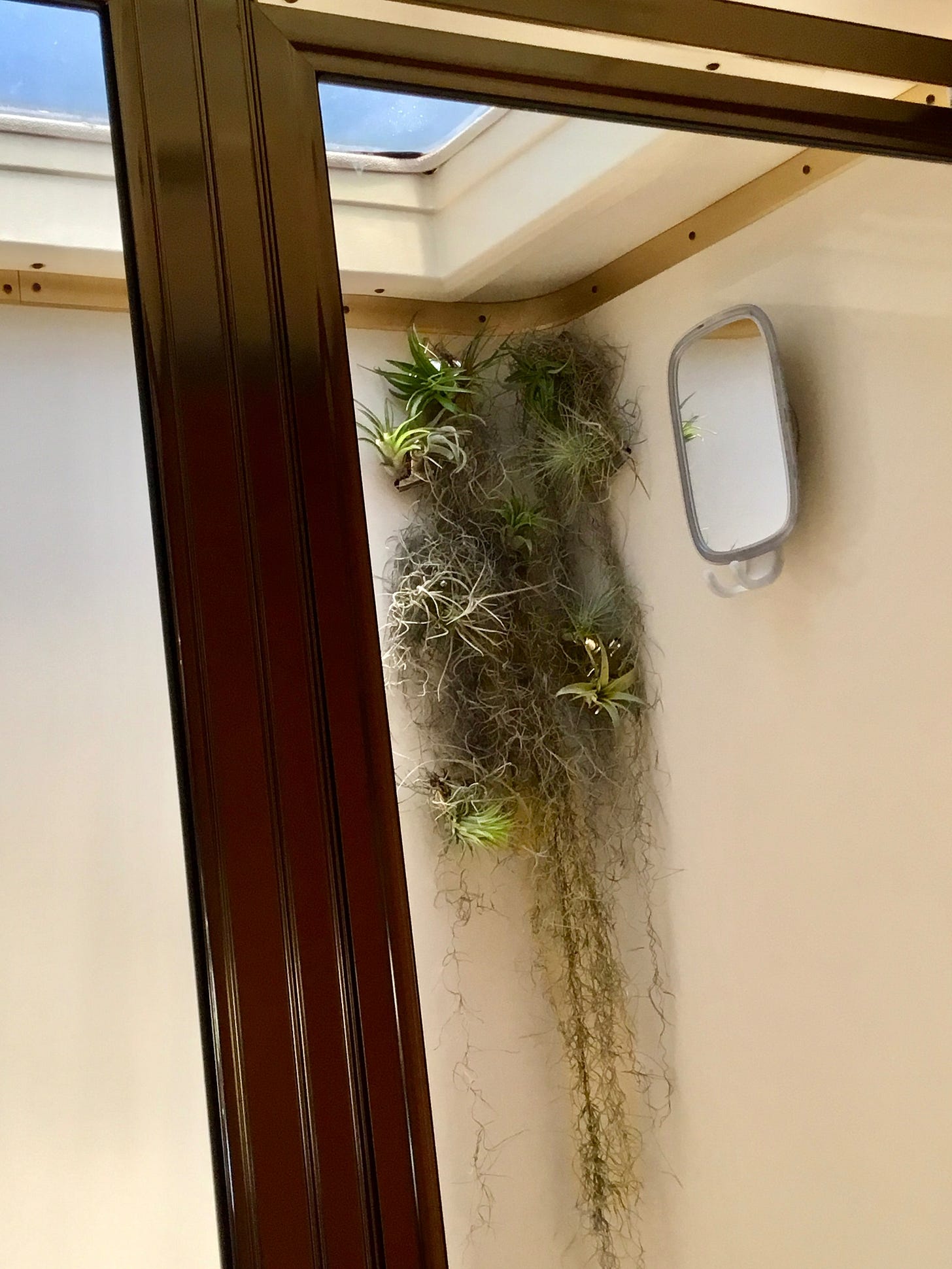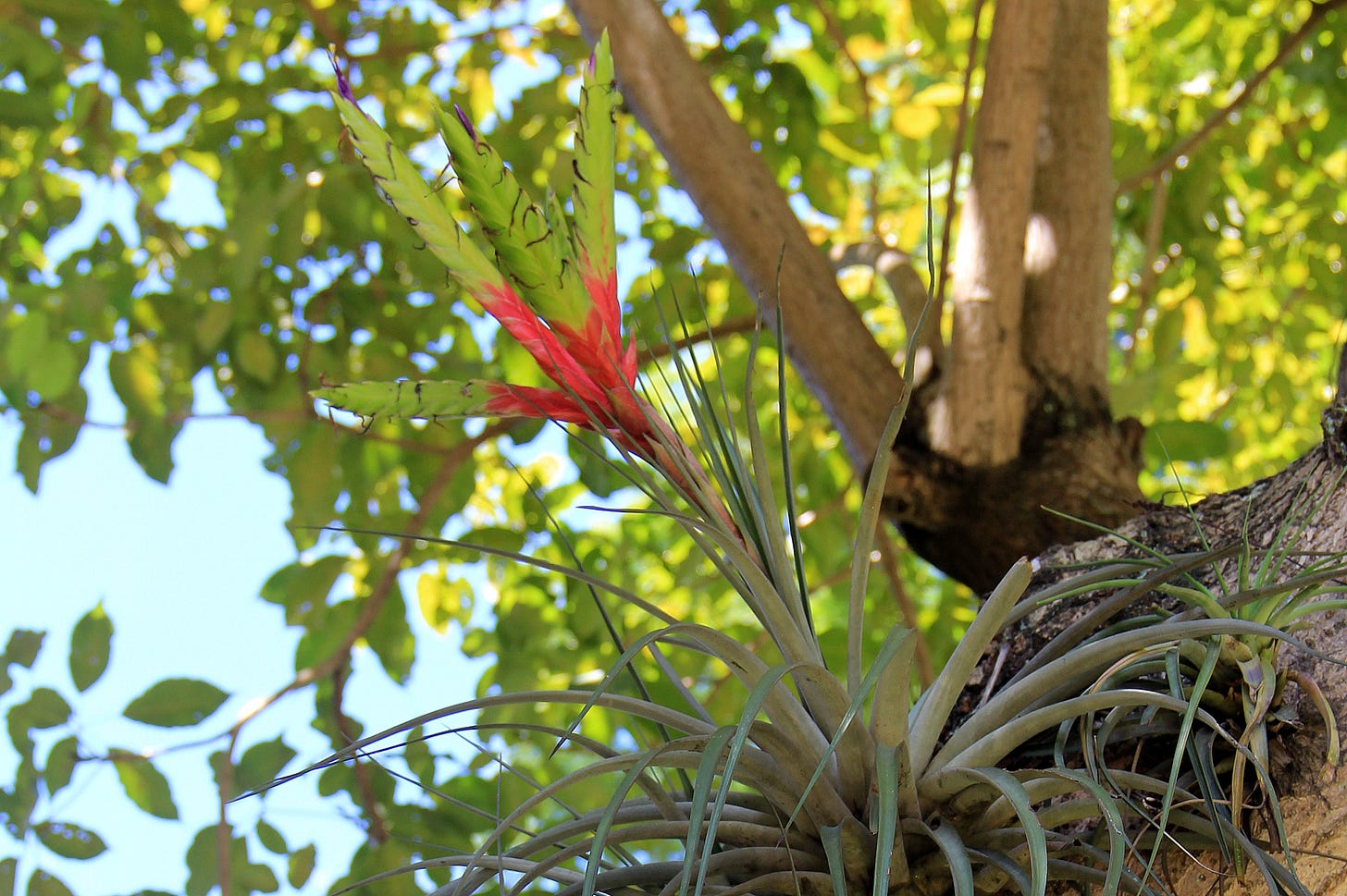Pt 27 Spanish Moss & Boondocking Bliss
Sometimes, when we take a moment to truly observe, we realize there's an entire hidden world waiting for us to tune in. Nestled within the crook of a branch were something I was honoured to witness...
As I sat parked beneath the sprawling Ocala live oaks, waiting for Ernie to return, I was in awe of all the green. The entire street was a canopy of live oaks, with an endless sea of lush foliage stretching in every direction. It reminded me of some of the resort properties I’ve visited in the Caribbean—different types of palm trees mingling with ferns and other happy plants, all creating a cool, shaded oasis while I waited.
Need to catch up?
Pt 25-From Pee Bottles to Peaches: The Unfiltered Truth of Life on the Road
Or, Start from the beginning
We were tucked into the corner of their modest-sized property, and at first, I thought we might be moochdocking. But as it turned out, we were actually boondocking. Now, for those unfamiliar with the RV lingo—moochdocking is when you park in a friend or family member’s driveway, running off their electricity like a friendly little parasite (but welcomed). Boondocking, on the other hand, is full self-sufficiency: no hookups, just you, your rig, and whatever resources you brought along.
There’s an organization called Boondockers Welcome, now owned by Harvest Hosts, that offers boondocking and moochdocking at its finest. It’s a network where RVers generously offer up their land to fellow travelers, providing a safe and welcoming place to stay for the night. Typically, there’s no exchange of money—just a spot to park, sometimes with access to a spigot or even a hookup (not that kind of hookup) like electricity.


I had a lot of work to catch up on, but I was absolutely ecstatic about my "office" setup and the view outside. Concentrating, however, was another story. With all this lush, tropical greenery surrounding me, it felt less like work and more like I had accidentally stumbled into vacation mode.
At the time, I had a podcast with a friend in the UK, and I was particularly excited for this one—because my half of the broadcast would be coming straight from Ocala, Florida. And where did I decide to record? On top of the Motorcoach, of course! I mean, if you have the chance to podcast amongst palm trees, why wouldn’t you?
After wrapping up work and checking in with my clients, I was looking forward to a peaceful night in the surrounding jungle of trees. No exploring today. Tonight was reserved for a dinner date with Ernie’s potential partners.
After a good meal and a "get to know you" chat, I was eager to get back to our coach, nestled in Florida’s finest greenery. I was absolutely thrilled about sleeping beneath the jungle-like canopy of trees. But even better? I could actually sleep in and not have to wake up early to hit the road again.
Maybe this is how touring bands feel—no hum of the engine, no bumps rocking you to sleep, just a solid bed on solid ground. Well, except for the gentle hum and vibration of the generator, which, honestly, made for the perfect white noise. As I drifted off, I wondered—could I ever go back to living in a traditional brick-and-mortar home again?
People always ask us if we have an end date in mind for this lifestyle. Truthfully, we never really thought about it. This is our end date. If I ever did leave the road life, one thing is for sure—I could never live in an HOA community with nosy, judgmental neighbors and a laundry list of ridiculous rules enforced by people who have nothing better to do than send out violation notices. No, thank you.
If I ever settled down, I think I’d escape to an island off Greece or Italy. Actually, if I won the lottery, I’d buy one of those crumbling villas—or even an entire town for a euro—and restore it. I’d turn it into a world-class health and wellness retreat where people could come from all over to breathe fresh air, drink clean water, eat naturally organic food, and refuel their weary bodies the way Mother Nature intended.
And with that dreamy vision mapping out my end game, I drifted off to sleep…

The next morning, I decided not to venture out. Instead, I surrendered to the stillness of the moment, soaking in the peacefulness of a new day. The air was crisp with the lingering coolness of dawn, slowly warming under the golden rays of the rising sun. I sat outside at my makeshift workstation—a simple table and chair—sipping my morning tea and listening to the symphony of birds greeting the day.
Ocala, in April, is alive with nature’s soundtrack. The cheerful trill of warblers, the rhythmic cooing of mourning doves, and the occasional piercing call of a hawk overhead created a layered harmony. Somewhere in the distance, a woodpecker drummed against a tree, punctuating the melody with nature’s own percussion. The fresh scent of damp earth and greenery mingled with the slightly sweet aroma of blooming jasmine, while the gentle rustling of the live oaks added to the soothing atmosphere.
I let the morning unfold slowly, appreciating the luxury of unhurried time. There was no rush, no agenda—just the simple pleasure of being in this beautiful space.
I decided to take a walk around the property, admiring the variety of plants thriving in this lush environment. The palms were plentiful, their rough, fibrous trunks warm beneath my fingertips, standing in contrast to the smooth, waxy leaves of a magnolia tree nearby. Bright ferns curled along the base of the trees, their delicate fronds unfurling like nature’s lacework.
But what truly captivated me was the Spanish moss. It hung from just about everything—trees, branches, even power lines—like nature’s own tinsel, swaying ever so gently in the breeze. From a distance, it appeared as delicate strands, almost ethereal, but upon closer inspection, I realized it was a dense weave of tiny plants clinging to one another, forming intricate, silvery-green ropes or, in some places, massive, cascading clumps. I was suddenly fascinated by this plant—neither moss nor parasitic, yet thriving in midair, drawing sustenance from the humidity around it.
There was something poetic about it. A reminder, perhaps, that even the simplest, most unassuming things in life have a quiet strength and beauty if you take the time to notice them.


Spanish Moss: The Gray Beard of the South
Spanish moss (Tillandsia usneoides), sometimes referred to as the gray beard of the South, drapes elegantly across landscapes from Florida to Texas. You’ll often spot clumps of it on lawns, draped over telephone poles, or swaying gently from power lines—carried by the wind like nature’s own confetti.
Despite its name, Spanish moss is neither Spanish nor a moss. It belongs to the bromeliad family—yes, the same family as pineapples—and is classified as an epiphyte, meaning it grows on other plants but does not harm them. These tiny perennial bromeliads have no true roots; instead, they pull all the moisture and nutrients they need from the air, rain, and sunlight.
For centuries, Spanish moss has been woven into human history. The Indigenous Houma people used it to treat fever and chills, while enslaved Africans brewed it into a tea to manage diabetes and asthma. At one point, Spanish moss was so abundant and versatile that it was used to stuff mattresses, sofas, chairs, and even car seats and home insulation. That’s a lot of moss!
Unfortunately, there’s a fair amount of misinformation surrounding Spanish moss. Some homeowners fear it’s damaging their trees, leading to unnecessary chemical spraying. In reality, Spanish moss does not harm trees. Unlike parasitic plants, it doesn’t steal nutrients or invade bark; it simply uses trees for support. The strands of moss catch everything they need from the air using tiny scales that absorb moisture and nutrients. During hot, dry periods, the plant can trap water to survive or enter dormancy until humidity rises again.
And then, of course, there’s the chigger myth. Some people believe Spanish moss harbors red bugs, also known as chiggers. Chiggers are the microscopic larvae of mites (Trombiculidae family), and while they can be found in damp, low-lying vegetation, Spanish moss itself isn’t the culprit. The problem occurs when moss falls to the ground, where chiggers are more likely to live. So, it's not that Spanish moss contains chiggers—it’s just that moss on the ground can pick them up
.Now that you’re probably scratching yourself just thinking about it, let me reassure you, I spent a lot of time up close and personal with Spanish moss and didn’t get a single bite! In fact, I even brought it indoors, filling my shower with flowing strands of moss and attaching air plants to create my own little rainforest. Before we left Florida, I returned them to the wild, and neither of us had a single chigger bite. So, let’s put away the chemical sprays and save the trees, the moss, and, frankly, our own lungs!
A Tiny World Waiting to Be Discovered
Sometimes, when we take a moment to truly observe, we realize there's an entire hidden world waiting for us to tune in.
While exploring Spanish moss up close, I made an incredible discovery—tiny, flowering air plants hiding in the trees! I had owned air plants back in Canada, but they never seemed to thrive. Now I understand why—like Spanish moss, they need the right environment: a humid atmosphere where the air itself carries the nutrients they need to survive. It breaks my heart to see air plants glued to ceramic trinkets in stores, doomed to wither and die, much like miniature Christmas trees destined for the curb after the holiday season.
As I examined a dense cluster of Spanish moss hanging from a tree, I noticed something even more fascinating. Nestled within the crook of a branch were several small plants—and one of them had a flower! I couldn’t believe my eyes. I was witnessing bromeliads in their natural habitat. It was like standing in the Arctic and spotting a wild polar bear. I was in awe.
Bromeliads, like Spanish moss, attach to trees but do so lightly, purely for support. They thrive in the air, pulling in what they need just like their Tillandsia cousins. Florida is home to 16 native bromeliad species, 10 of which are listed as threatened or endangered, plus two natural hybrids that cross-pollinated on their own. It was astonishing to realize how many were hiding in plain sight, waiting for someone, anyone, to stop and appreciate them. I felt honored to be that person.
One of the most common species I found was the Florida catopsis (Catopsis floribunda), a rare and endangered bromeliad. Unlike Spanish moss, which cascades in strands, this plant formed elegant rosettes of silvery-green leaves that funneled rainwater toward its base. Another stunning find was the Leatherleaf Airplant (Tillandsia variabilis, syn. T. valenzuelana), with its soft, fuzzy leaves. And then there was the Fuzzywuzzy Airplant (Tillandsia pruinosa, syn. T. breviscapa), which looked like a tiny plant straight out of a fairytale. The Ball Moss (Tillandsia recurvata, syn. Diaphoranthema recurvata) reminded me of tiny floating orbs—something fairies might use as lanterns.
Bromeliads and Spanish moss play crucial ecological roles. They act as natural water collectors, helping to sustain microhabitats within trees. Their funnel-like structures trap rainwater, creating tiny reservoirs where insects, and even small birds can find hydration. Some species even support entire ecosystems within their leaves, offering shelter to reptiles, amphibians, and bats.
However, their biggest threats are not natural ones. The top three dangers to bromeliads are:
Illegal collecting – Rare bromeliads are often harvested and sold to plant collectors, disrupting fragile ecosystems.
Mexican bromeliad weevils – These invasive pests destroy bromeliad populations by feeding on their cores.
Habitat loss – Urban development, deforestation, and the spraying of harmful chemicals are wiping out entire bromeliad communities.
One lesson I taught my daughter at a young age was this: If you pick a flower, no one else can enjoy it. Instead, take a photo and enjoy it forever while leaving its beauty for the next person to experience the same sense of wonder.
Thankfully, today we carry high-quality cameras right in our pockets. Instead of removing something from nature, we can capture its essence, share its beauty with others, and leave the original masterpiece untouched, waiting for someone else to stumble upon it and be just as enchanted.
Doesn’t that just feel right?
Next week, we’ll dive into exploring Ocala, uncovering its hidden gems, scenic landscapes, and the places that make it truly unforgettable. I will see you then.
If you have not subscribed yet, why not? If you are subscribed, you will be alerted as soon as the next story drops and it will come effortlessly into your inbox or an alert on the app every Wednesday morning. So, hit that blue button right there and subscribe now. Jaggies, Zazu and I Thank you!
Once you do that and are feeling all kinds of fuzzy feels, how about tipping the Tipsmobile?
If my adventures and stories are bringing a smile to your face, why not throw a little fuel in my tank to keep the wheels turning —literally! Even creativity needs a top-up now and then! Your support keeps me inspired, and rolling down the road. Thanks for being part of the journey!
Need to catch up?
Pt 25-From Pee Bottles to Peaches: The Unfiltered Truth of Life on the Road
Or, start from the beginning
Thank you for tuning in and reading this. I super appreciate you.
~Karen









We do pair up through our dreams :)
Poor Spanish Moss gets a Bad Rap!